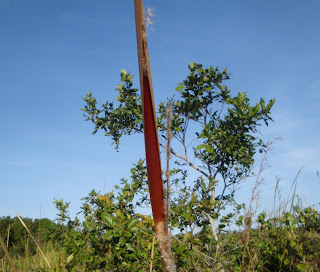This is stretching the definition of "natureza" somewhat, but it is kind of interesting.
Just recently an international* group announced the first "possible" life supporting planet, Gliese 581d**. Not that it DOES have life, just that it could. Gliese 581 is in the constellation of Libra, about 2 degrees north of the brightest star there, Beta librae - look high in the sky, more or less due East from Vitoria, Brazil at 9 o'clock at night at the moment.
At first sight Gliese 581d, orbiting the red dwarf Gliese 581, doesn´t look very much like home. For a start it is about 5-7 times bigger, but more importantly it receives only about 1/3 as much sunlight as Mars, let alone us, so any water there should be frozen solid. It also probably orbits with one side always facing the sun, so has a permanent dark side. However, computer modelling shows that it might be a little more complicated.
A dense atmosphere heavy in CO2, which would match planets in our solar system, would act like a blanket - the famous greenhouse effect. This would raise surface temperatures above the melting point of water, so you would have liquid water, which is essential for life (as we know it).
So what would it be like there? Well, pretty dark at the best of times, and maybe completely dark in some places, with what little light there is being red from the red dwarf star. Lots of CO2 in the air so we probably couldn't breath without masks, and we would feel very heavy, gravity being about twice what we are used to.
All this is speculation, but it might not be much longer before we know more. Gliese 581d is not that far away - well, it is, 20 light years, but relatively not that far. So probably before long telescopes will be good enough to get at least a light spectrum which would tell us a lot about the atmosphere, especially if it's green!
And... there might be another way. In October 2008 a group in Ukraine beamed a message directly to Gliese 581 using a high powered radio telescope, it should arrive in 2029. An answer would arrive in 2049.
* A French/ English group led by a Swiss using a telescope in Chile. Wordsworth et al 2011, Astrophysical Journal Letters
** It doesn't have a proper name yet, nor does the star. Any suggestions?
Saturday, 28 May 2011
Thursday, 19 May 2011
Taboa
This is taboa (Typha dominguensis), a common perennial reed. Very very common! Actually, it has spread to tropical and temperate regions all over the world, in marshes and wetlands, even mangrove swamps. It shoots up to about 2 metres tall and releases millions of seeds, so it quickly takes over any area where it becomes established and can be something of a nuisance.
Has it's uses though. The fibre is tough and durable and can be used to make baskets and handicrafts, even paper. In Turkey the flower stalk is applied to burns and wounds and apparently works quite well.
Perhaps it's most beneficial property though is as a sponge. As it grows, taboa absorbs vast amounts of material from the water around it, most of which accumulates in it's tissues. So taboa beds can absorb Phosphorous from agricultural runoff which would otherwise cause algal blooms, or even heavy metals like Zinc from mining pollution. You just wait and then cut and take away the reeds. There are several studies around the world deliberately making lagoons of Typha dominguensis as a low cost way of cleaning waste water.
 It's hard to say whether taboa is such a benefit environmentally. It swamps (as it were) native species in clean water, but cleans polluted water so that other creatures can survive, as well as providing cover for insects and small fish. Anyway, it can be very useful for us humans.
It's hard to say whether taboa is such a benefit environmentally. It swamps (as it were) native species in clean water, but cleans polluted water so that other creatures can survive, as well as providing cover for insects and small fish. Anyway, it can be very useful for us humans.
Has it's uses though. The fibre is tough and durable and can be used to make baskets and handicrafts, even paper. In Turkey the flower stalk is applied to burns and wounds and apparently works quite well.
Perhaps it's most beneficial property though is as a sponge. As it grows, taboa absorbs vast amounts of material from the water around it, most of which accumulates in it's tissues. So taboa beds can absorb Phosphorous from agricultural runoff which would otherwise cause algal blooms, or even heavy metals like Zinc from mining pollution. You just wait and then cut and take away the reeds. There are several studies around the world deliberately making lagoons of Typha dominguensis as a low cost way of cleaning waste water.
 It's hard to say whether taboa is such a benefit environmentally. It swamps (as it were) native species in clean water, but cleans polluted water so that other creatures can survive, as well as providing cover for insects and small fish. Anyway, it can be very useful for us humans.
It's hard to say whether taboa is such a benefit environmentally. It swamps (as it were) native species in clean water, but cleans polluted water so that other creatures can survive, as well as providing cover for insects and small fish. Anyway, it can be very useful for us humans.
Saturday, 7 May 2011
Borboletas
It´s autumn in the southern hemisphere, but it feels like spring with the appearance of flowers and suddenly quite a few butterflies ("borboletas"), the most common of which seems to be this one...
 I managed to identify it as the Mangrove Buckeye (Junonia evarete) thanks to the excellent field guides from fieldmuseum org (http://fm2.fieldmuseum.org/plantguides/guide_pdfs/X016-Iracambi-Butterflies.pdf ). As its name suggests, the Mangrove Buckeye rather likes mangroves, in fact from Florida to southern Brazil it is a bane of attempts to reforest coasts with these trees, the caterpillars stripping young seedlings. It's not just mangroves though, caterpillars eat Gervao (Stachytarpheta cayennensis), also know as "Brazil tea", and Sempre viva (Paepalanthus polyanthus) as well as others.
I managed to identify it as the Mangrove Buckeye (Junonia evarete) thanks to the excellent field guides from fieldmuseum org (http://fm2.fieldmuseum.org/plantguides/guide_pdfs/X016-Iracambi-Butterflies.pdf ). As its name suggests, the Mangrove Buckeye rather likes mangroves, in fact from Florida to southern Brazil it is a bane of attempts to reforest coasts with these trees, the caterpillars stripping young seedlings. It's not just mangroves though, caterpillars eat Gervao (Stachytarpheta cayennensis), also know as "Brazil tea", and Sempre viva (Paepalanthus polyanthus) as well as others.
 With this diverse food range it can be found far from the coast and mangroves, from Belo Horizonte in the inland mountainous state of Minas Gerais, to Brasilia, over 700 miles from the sea.
With this diverse food range it can be found far from the coast and mangroves, from Belo Horizonte in the inland mountainous state of Minas Gerais, to Brasilia, over 700 miles from the sea.
 Adult females and males can be easily told apart as the males have blue patches (top) whilst the females are more discrete (above). Both have a fast and fairly erratic flight and reportedly prefer the small flowers found in grassland by roads or recently neglected land, certainly I saw these on flowers amongst long grass.
Adult females and males can be easily told apart as the males have blue patches (top) whilst the females are more discrete (above). Both have a fast and fairly erratic flight and reportedly prefer the small flowers found in grassland by roads or recently neglected land, certainly I saw these on flowers amongst long grass.
 I managed to identify it as the Mangrove Buckeye (Junonia evarete) thanks to the excellent field guides from fieldmuseum org (http://fm2.fieldmuseum.org/plantguides/guide_pdfs/X016-Iracambi-Butterflies.pdf ). As its name suggests, the Mangrove Buckeye rather likes mangroves, in fact from Florida to southern Brazil it is a bane of attempts to reforest coasts with these trees, the caterpillars stripping young seedlings. It's not just mangroves though, caterpillars eat Gervao (Stachytarpheta cayennensis), also know as "Brazil tea", and Sempre viva (Paepalanthus polyanthus) as well as others.
I managed to identify it as the Mangrove Buckeye (Junonia evarete) thanks to the excellent field guides from fieldmuseum org (http://fm2.fieldmuseum.org/plantguides/guide_pdfs/X016-Iracambi-Butterflies.pdf ). As its name suggests, the Mangrove Buckeye rather likes mangroves, in fact from Florida to southern Brazil it is a bane of attempts to reforest coasts with these trees, the caterpillars stripping young seedlings. It's not just mangroves though, caterpillars eat Gervao (Stachytarpheta cayennensis), also know as "Brazil tea", and Sempre viva (Paepalanthus polyanthus) as well as others. With this diverse food range it can be found far from the coast and mangroves, from Belo Horizonte in the inland mountainous state of Minas Gerais, to Brasilia, over 700 miles from the sea.
With this diverse food range it can be found far from the coast and mangroves, from Belo Horizonte in the inland mountainous state of Minas Gerais, to Brasilia, over 700 miles from the sea. Adult females and males can be easily told apart as the males have blue patches (top) whilst the females are more discrete (above). Both have a fast and fairly erratic flight and reportedly prefer the small flowers found in grassland by roads or recently neglected land, certainly I saw these on flowers amongst long grass.
Adult females and males can be easily told apart as the males have blue patches (top) whilst the females are more discrete (above). Both have a fast and fairly erratic flight and reportedly prefer the small flowers found in grassland by roads or recently neglected land, certainly I saw these on flowers amongst long grass.
Subscribe to:
Comments (Atom)



